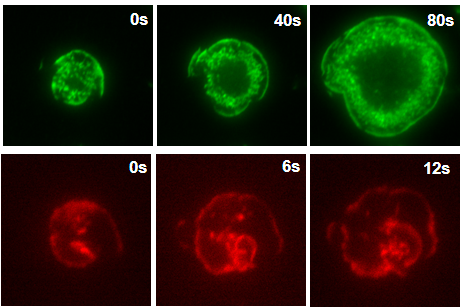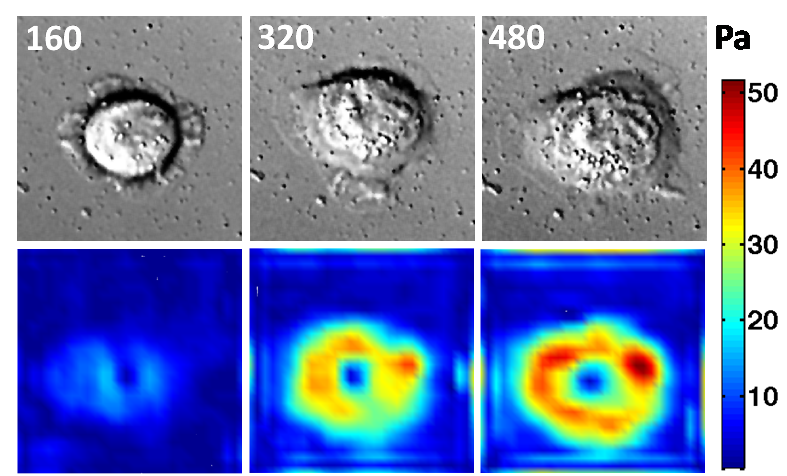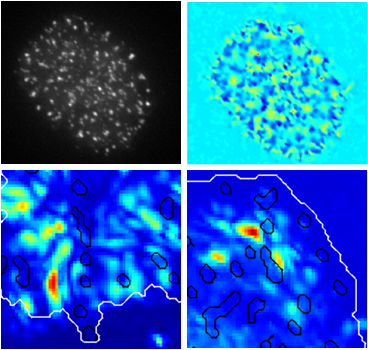Physical aspects of T cell signaling
The interplay of physical forces and biochemical signaling pathways is critical in driving many biological phenomena including the immune response. T cells, which are central players in the immune response, bind to antigen presenting cells through specialized receptor-ligand interactions. Receptor engagement initiates actin dynamics which leads to deformation of the cell membrane and spatial patterning of signaling proteins into micro-clusters which are essential for signaling. We aim to understand the physical mechanisms governing contact formation between immune cells, signaling and spatial organization of signaling proteins.

Actin dynamics in T cells: Actin reorganization is critical for the immune synapse formation and signaling activation in T cells. Using TIRF microscopy, we visualize the dynamics of actin, actin regulatory proteins and signaling molecules during early spreading of Jurkat T cells on a stimulating surface. We found that the actin cytoskeleton organizes into non-equilibrium patterns such as membrane coupled actin waves which appear to emerge from signaling clusters [Hui et al., 2013]. Actin-membrane waves may enable cells to dynamically scan the target surface, increasing receptor-ligand interactions and subsequent T cell signaling.

Cytoskeletal forces and T cell signaling: The link between physical forces and TCR signaling activation is an open question. It has recently been shown that externally applied forces can activate TCR signaling, indicating a potential role for forces. We have examined the role of internal cytoskeletal forces during T cell signaling activation. We used traction force microscopy to directly measure the forces generated during Jurkat T cell spreading on a stimulatory surface. We found that T cell forces are largely generated by actin assembly dynamics with limited contribution from myosin. Jurkat T cells also exhibit mechanosensitivity to substrate stiffness, exerting larger forces on stiffer surfaces, and altered morphology and signaling. Our results suggest that actin generated forces may be important for signal transduction in T cells.
Membrane fluctuations:
 Biochemical signaling at interfaces is subject to physical constraints such as membrane topography and bending which modulate receptor ligand interactions. Membrane fluctuations normal and tangential to the surface may affect the lifetime of bonds and interaction energies between receptors and ligands. We used IRM to examine the membrane topography and nanometer scale height fluctuations of Jurkat T cell membranes contacting an activating surface. Signaling clusters were correlated with domains of strong adhesion and low fluctuations, indicating that membrane topography is an important parameter governing the spatial assembly of signaling [Hui et al. Biophys J., 2012].
Biochemical signaling at interfaces is subject to physical constraints such as membrane topography and bending which modulate receptor ligand interactions. Membrane fluctuations normal and tangential to the surface may affect the lifetime of bonds and interaction energies between receptors and ligands. We used IRM to examine the membrane topography and nanometer scale height fluctuations of Jurkat T cell membranes contacting an activating surface. Signaling clusters were correlated with domains of strong adhesion and low fluctuations, indicating that membrane topography is an important parameter governing the spatial assembly of signaling [Hui et al. Biophys J., 2012].
Lab Members Involved: David Garcia, Kaustubh Wagh
Collaborators: Papoian Lab, UMD Chemistry & Samelson Lab, National Cancer Institute
Funding: NSF Physics of Living Systems
